-
Posts
3,220 -
Joined
-
Last visited
Content Type
Profiles
Forums
Gallery
Events
Posts posted by Hubac's Historian
-
-
Thank you, Cedric! So far, I'm only two thirds of the way through one hull half, and that doesn't include the upper bulwarks. I could project the math and figure out, roughly, how many holes there are a side, however, I don't have the thing in front of me, right now. My guestimate would be somewhere in-between 2,000-2,500 per hull half. The upper bulwarks will add considerably to that. Maybe somewhere in the range of 8,000 holes when all is said and done. It's okay, time is still on my side.
Either today or tomorrow, the spare parts that Henry (Popeye2Sea) has so generously donated to my experimental hull expansion project - "Le Franken-Royal" - should arrive. The hull parts he is sending me were too badly warped to make a model from, but the small bits I need for the bow and stern should be perfectly useable. I'll use what's left to work up paint samples. I really want to see what impact different primer colors (flat black, primer grey, flat white) have on this color Ventre de Biche.
When are you sending me updates, Cedric?
-
I was kind of hoping you would disappoint me - even just a little bit - so I could feel a little better about my relative talents and abilities 😉. You know - maybe, a slightly open seam, or worse - the use of off-color putty as filler, or maybe an errant fastenner or two. Maybe a weird dip or bump in the hull. But nothing. Nope. Nada. Zip! Just a seamless work of utterly awesome perfection 👏👏!!
Marc, I can see a little better the arc of your sheerline, in these pictures, and I think that it looks really very good. Maybe it could drop a liiiiiittle more, but it is not as straight seeming as I thought before. It's just a problem of perspective, where none of these pictures focuses on the rise of the sheer, so it is difficult to perceive.
One little bit of fun, is to use the screen margin of my phone, to scroll down (on several pics) so that the ship appears to sit on her waterline. The figure she cuts in this view is absolutely a convincing portrait of a 17th Century first-rate ship. Even without all of the ornamental embellishments, one can see where this is headed. And that is not to minimize the form of the lively works, which display perfect symetry and a sense of draft befitting of such a heavily armed ship.
BRAVO, Marc!!
- FrankWouts, Nek0, md1400cs and 1 other
-
 4
4
-
-
-
-
You have to be careful with those CA glues. In my twenties and thirties, none of that stuff bothered me. We were using massive amounts of West System epoxy, and washing it off our skin with lacquer thinner. Stupid. Now I find I am sensitive to funes from curing epoxy. Same with CA glue. I used to use it a lot, but now I find that I can't tolerate the fumes. Make sure you ventilate. And if you are using a lot of that stuff, go get yourself an organic vapor respirator.
All that being said - the ship really looks beautiful EJ. Great work! Sorry about the soapbox. I just wish I had taken that stuff more seriously when I was younger.
-
I have been busily mapping out and drilling nail impressions in the deadworks. I haven't put a caliper to the bit I'm using, but suffice it to say that it is near impossibly small. There was some trial and error to arrive at a bit that left a plausible impression, and that didn't overheat and clog with melted plastic too quickly. I still have to stop the Dremel and clear the bit every 15 holes, or so, but that's much better than the 5-8 range.
As a quide to my spacing, I am using the exposed timber heads of the caprail. This works out to about 5/16", on center for the most part, but there are several instances where I'll have to run a row or two at 1/4" spacing, in order to maintain overall consistency.
In the waist, and for about six ports aft of the waist ladder, the nailing pattern runs perpendicular to the waterline. With the hull half sitting on the table, I simply use a try square to align my blue painter's tape guide for keeping my lines nice and straight. As the sheer rises, further aft, it has become necessary to skew my tape guides ever so slightly, by eye, so that my nailing pattern doesn't run too far askew of the gunport framing, with which it should remain parallel.
After much deliberation, I have decided to mimic the alternating nailing pattern that Dan Pariser used for his very thoroughly researched and excellent Queen Anne's Revenge. I have known Dan for a long time now, and there is nothing he does without considerable thought and research.
Here are a few pics of my progress, so far. They are hard to make out in the black plastic, and after priming and painting they should just barely show as faint impressions.
- mtaylor, BLACK VIKING, CédricL and 7 others
-
 10
10
-
-
-
-
Thanks Daniel! As far as Soleil is concerned, the shame of it is that they do an incredible job of copying the ornamental details from one of the existing original cannons, but as I say, they do not capture the appropriate sense of girth that is so evident in every Van de Velde portrait ever drawn.
For carriage and rig updates to the guns, I am looking very closely at Popeye2Sea's excellent build log. His carriages look amazing.
I'll have to look at those links for photo etch; thank you for the info.
-
Hi Daniel,
One question about the guns:. The scale of the barrels looks really good. While I have this kit, it's siting in a basement in PA and I can't readily look at it. Are these the stock cannons, or did you make/buy something closer to scale?
One of my issues with Heller's Soleil Royal is that the muzzle/barrel width, and bore diameter are too narrow and spindly looking. I will have to do something about this, and am searching for a way to perhaps recycle the kit's stock barrels by, perhaps, dipping them several times in some sort of resin, in order to increase their breadth. I could then drill out the appropriate bore diameters. I am wondering your thoughts on this subject.
thanks,
Marc
- CaptainSteve and dafi
-
 2
2
-
Okay Daniel, I'm only on page 3 of your build log - and I'm going to stop hitting the like button, so that you are inot completely innundated with notifications, but...
I am completely BLOWN AWAY by your attention to detail and your willingness to re-work the smallest details until they are RIGHT.
My German half is crying meticulous tears of joy!
Gonna keep reading
- mtaylor and CaptainSteve
-
 2
2
-
Well, that is just about the only case of "herpes" I would welcome in my life
 ; pretty to look at, and no painful rash!
; pretty to look at, and no painful rash!
Well done, Michel!
- dvm27, FrankWouts, EJ_L and 1 other
-
 4
4
-
I hopscotched through another member's (who had visited my build) history log and found your highly intriguing build of the Heller Victory. I so like the excellent modifications and scratch-work on this main top, that I'm going to go back and read through your whole log. It seems that much of what you are doing might be really helpful to me, even if we are building in different centuries.
So nice to see such excellent, clean work. I'm looking forward to catching up!
-
-
P.S. I'm not sure why the above text is underline formatted, because I did not do that deliberately, and underline in the toolbar is not highlighted, when you select text in that block. I can't seem to correct it, so there it is.
If you look closely, you'll see that I even placed carriage tackle bolts on the skids that frame the ladder, because the skid frames took up all available space, immediately next to the affected ports. I'm not sure whether that is a correct detail, either, but it seemed like the sort of accommodation a builder would make under the circumstances.
I'm approaching the end of my lower hull modifications. Those are a lot of tiny bits of plastic! After the "nailing," I'll do the bow and stern extensions, re-locate the hawse-holes, and then I will probably focus on making the alterations and additions to the upper bulwarks. After that, I will have to figure out my drawing problem.
- hexnut, rybakov, CaptainSteve and 5 others
-
 8
8
-
-
Okay, then what about this:
Mask your line, top and bottom as perfectly as your eye enables you to do - having cut sufficiently long strips of masking tape to make nearly one complete run, stem to stern. The complicating curves at the bow and stern need to be dealt with in shorter lengths. You will have first ripped your tape into no more than 1/8" strips, this will enable you to easily stretch and adjust your tape to move as needed, with the sheer, etc.
Once you have the line masked the way you want it, thoroughly burnish the tape with a straight piece of stiff card. Then mask as near to the line with a wider swath of masking tape. Then mask off everything else above and below the line with paper.
Here's the critical step:. Spray the, as yet, uncolored line with a clearcoat that matches the desired sheen of the rest of the model. Once that's dry, airbrush in your color wih a few light coats.
If, after removing your masking, you see any areas where the clearcoat has blead under the tape - simply mask off your line in the affected areas, level the clear coat, and when the time is right in your process - spray the whole .thing one last time with that matching clear coat.
Failing all that, pour me a glass of bourbon on a slow evenning, and I'll tape off your lines to perfection.
-
-
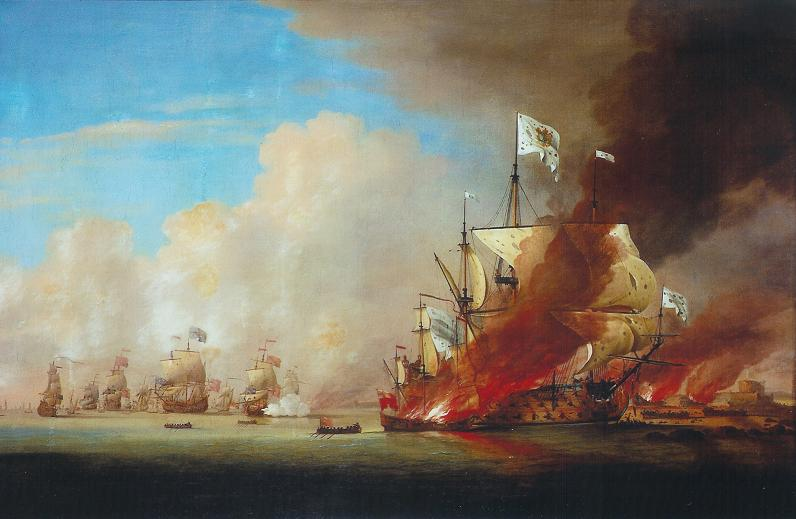 The funny thing is that I just sent Marc a PM, discussing this paint issue, among other subjects. But, I had not yet read his last entry into my build log. For the sake of the public conversation, I will copy and paste the relevant portion of that message - the irony can't be beat!
The funny thing is that I just sent Marc a PM, discussing this paint issue, among other subjects. But, I had not yet read his last entry into my build log. For the sake of the public conversation, I will copy and paste the relevant portion of that message - the irony can't be beat!
~~~
it seems that a number of well-known French models make use of the color (ventre de biche), as a painted color, on the dead works: Le Fleuron (red, yellow ochre, ventre de biche), Le Temeraire (Tusset model), and Le Ville de Paris are three well-known examples. But then, I was looking at the replica of Hermione, and she too appears to have her deadworks painted in this brownish, yellow color. And then, I looked once again, at a second Peter Monamy painting of the destruction of SR, which focuses on the bow:
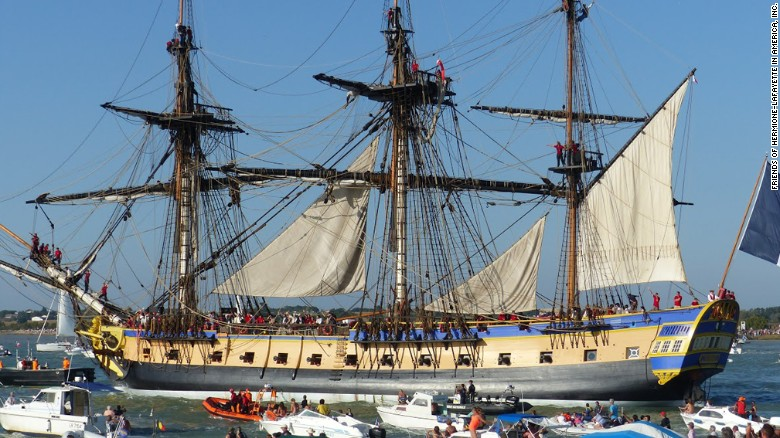
Here, too, ventre de biche appears to be a deliberate and applied color. What all of this means for me is that I will have to work up a series of paint samples; one that is a lightly weathered, natural wood tone, one that is VDB freshly applied, and one that is VDB lightly washed to show a little sea grime. As this is going to be a diorama model, I just want to avoid an overly painted looking model; sort of the way a girl wants to look as though she isn't really wearing make-up, if that makes sense to you.
~~~
And, by the way, I also agree with Marc that one must first understand what was, or likely was, before taking any divergent paths. The question of combining yellow ochre for much of the moulded work with gold for the important sculptural work would be an artistic decision for me on the basis that those golden ornaments would then stand out better, in relief; they would be more impact-full.
- CaptainSteve, mtaylor, EJ_L and 2 others
-
 5
5
-
Exquisite work on the guns, Marc! I agree with you, also, that Victor really captures the essence of what a sailing man-o-war must have been like, on the water. To me, his ships are perfect miniature recreations. And on launch day, your miniature Tourville will spring to life and take command of his reborn Royal Sun.
Well done, my man! Well done!!
- Nek0, FrankWouts and mtaylor
-
 3
3
-
Thank you, Marc! I will tell you that I have been thinking about your suggestion for the anchor lining - that it should fill-in completely between the lower main wales, right up to the stem. After looking through my image database, virtually all French models confirm this detail. I will do so, as well, but only after I add on the bow extensions. The anchor lining will provide the added benefit of making this joint a little stronger.
I am also now changing my mind again and leaning towards representing only regular iron nails in the deadworks, but I will have to arrive at a method that suggests a believably subtle pin-prick. Dan's earlier suggestion to draw-in the nails with a mechanical pencil does not work well on this particular model because of the pronounced moulded grain.
For the sake of comparison, I will also try to simulate tree-nails with a sharpened syringe needle. What I choose may depend upon which effect reads better visually. In that instance, even if the type of fastenner isn't correct, there has at least been some attempt made to show fastenners in a sensible pattern.
I will find a way. Herbert Tomesan suggests very shallow nail holes on his models. The trick is to find a repeatable method that will look good thousands of times.
-
All of this detail gets added on before painting. In fact, I probably won't paint anything until the hull is assembled, the lower transom built and interior gussets and supports for the second gun deck are in place. I want to get all the major handling out of the way before I put finish colors on. I will probably even have built up and installed the quarter galleries, up to the main deck level, before paint.



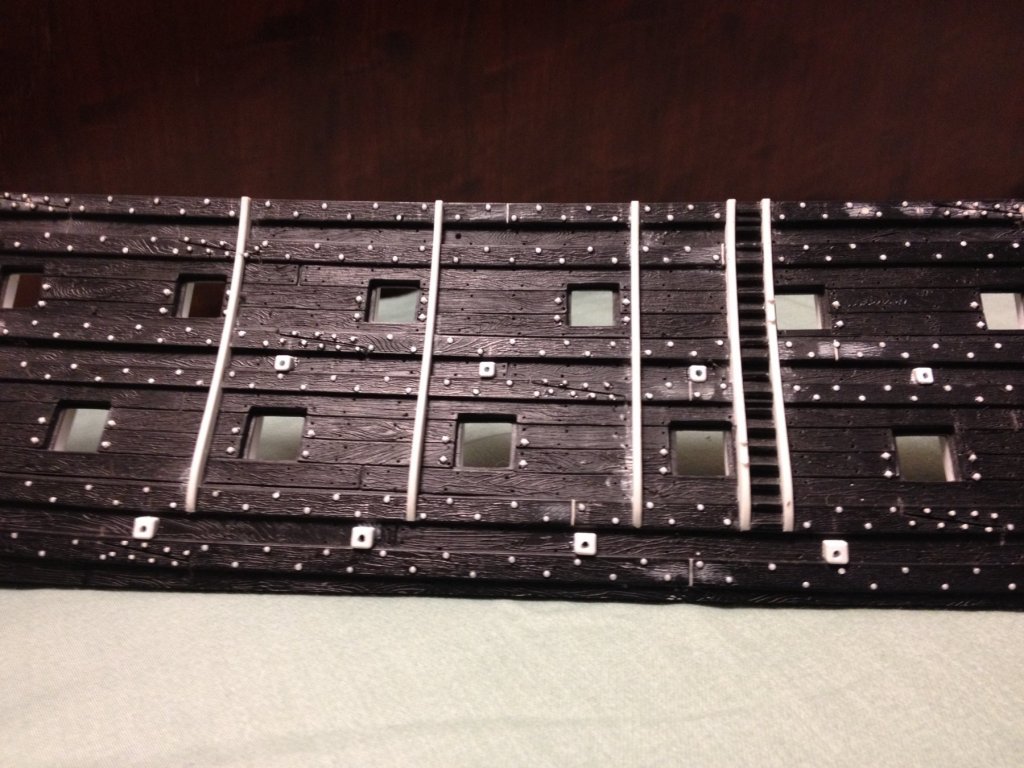
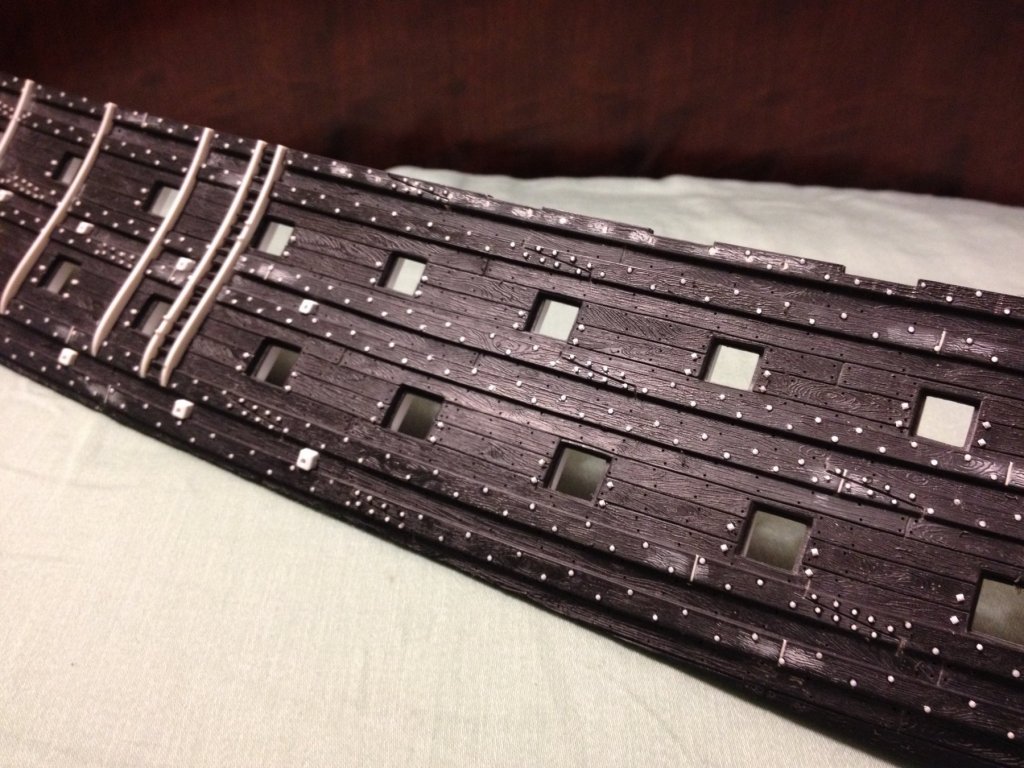
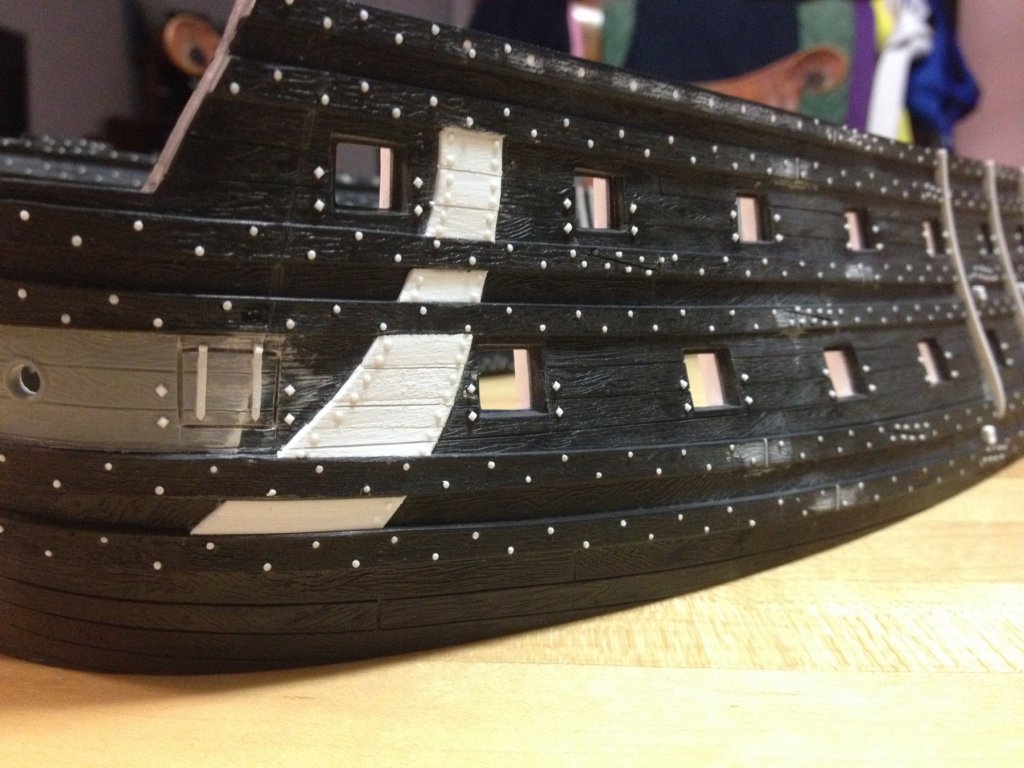
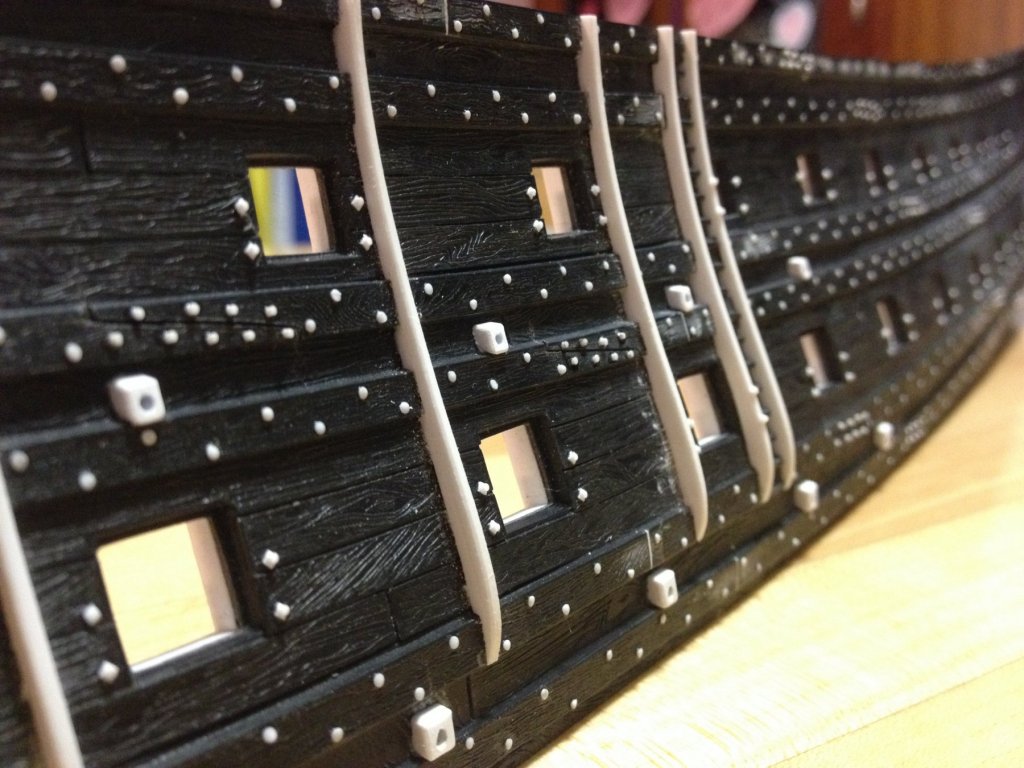
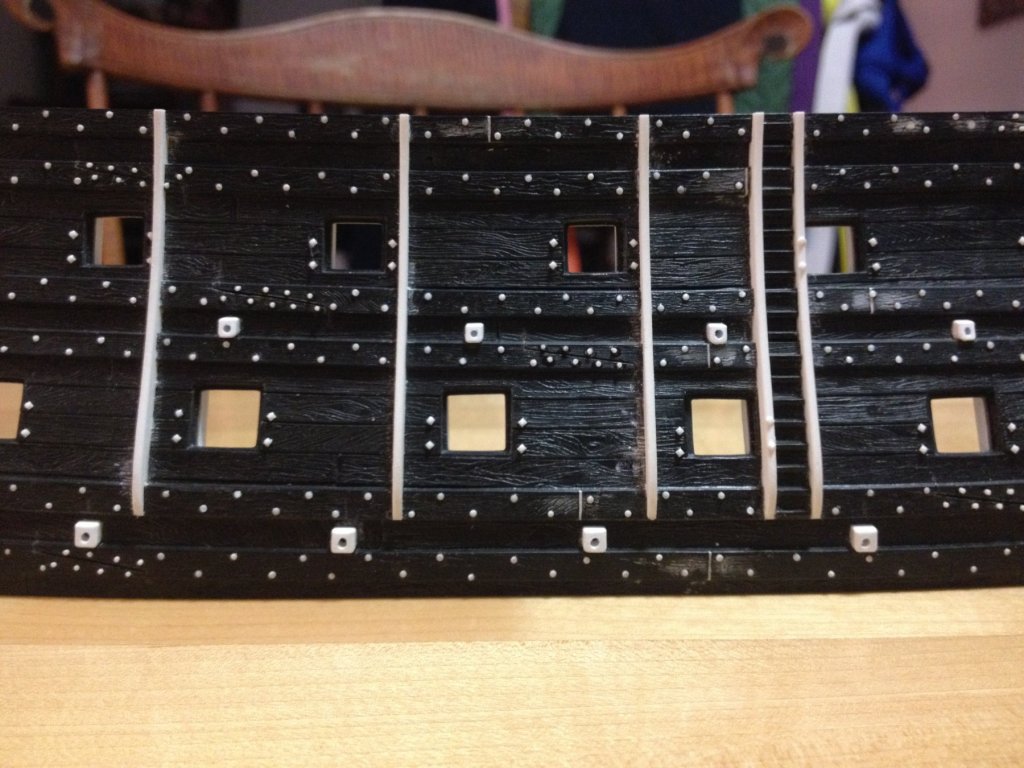
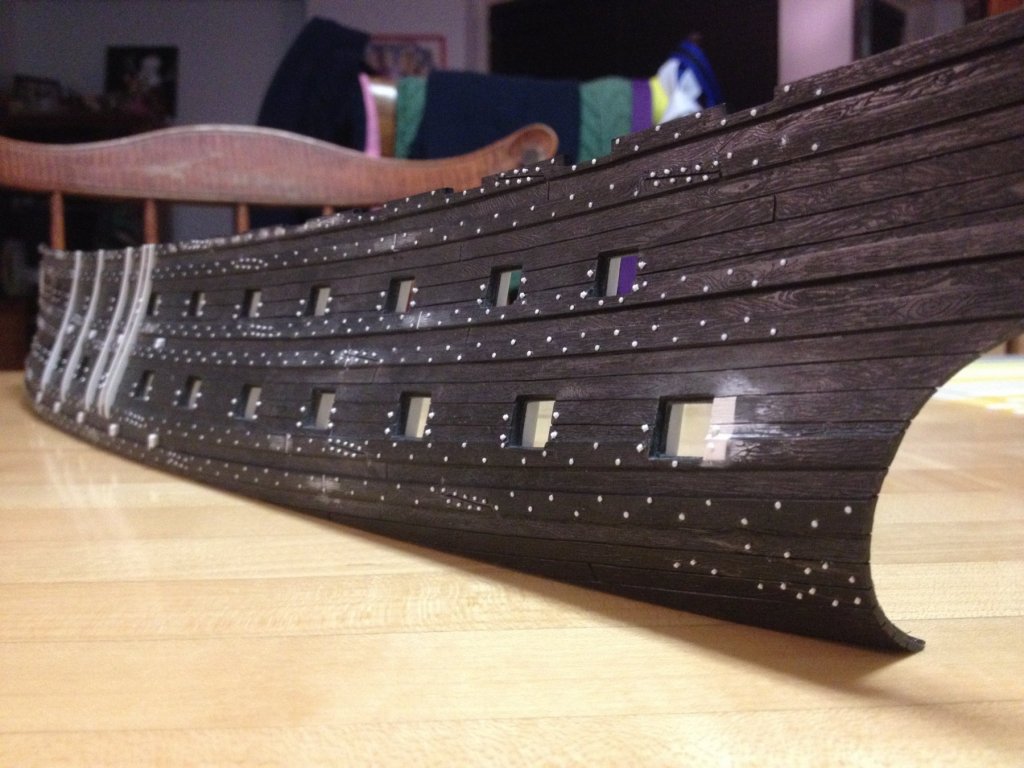
Wasa by md1400cs - FINISHED - Corel - 1:75
in - Kit build logs for subjects built from 1501 - 1750
Posted
I am quietly enjoying this excellent build-log, and I am hoping that you guys can enlighten me on something that I've seen mentioned a few times here:
What is, or what will be Vasa II? A new kit? A full-size replica project with appropriate draft and beam, in order to actually sail?
Whatever it is, it sounds interesting.